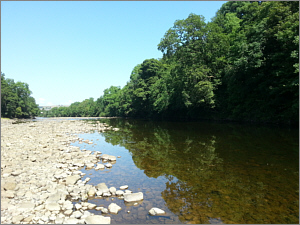When to Fish
Sea Trout Fishing on British Sea Trout Rivers
|
|
In the Where to Fish section, we looked
briefly at where we might hope to catch sea trout and found
worthwhile opportunities in most parts of the British Isles,
from Connemara to Carmarthen, from Caithness to Cornwall.
When, though, is the best time to go in search of sea trout?
As a general rule, the best of the sea trout fishing in the
British Isles is undoubtedly to be had in June and July. Sea
trout will then be present in the majority of our rivers
and, in the clearer streams, may be observed resting in the
main pools during daylight hours. I would expect most of our
rivers to follow this pattern, so much so that, if I was
planning a sea trout week on any river in the British Isles,
I would be most unlikely to choose a week earlier than June
or later than July, with the last two weeks in June and
first two weeks in July generally being prime sea trout
time. Fresh sea trout will continue to run during August,
and even later in some rivers, but, as the season
progresses, we can expect that all sea trout will naturally
be more advanced in their spawning cycle and the probability
of catching a coloured fish will increase with the passing
weeks.
|
 |
 |
|
Sea Trout
Water |
A Summer Sea
Trout from The Spey |
The specific timing of the sea trout runs
does vary from river to river. Generally, though, sea trout
will begin to run in numbers in early summer, perhaps in
May, and numbers will build up during June and July and into
August. Successful tactics for sea trout can vary somewhat
from river to river and region to region but, in general,
the hours of darkness are the most productive. Although the
larger sea trout, on most rivers, tend to run early in the
season, the nights before about mid May, here in Scotland
anyway, tend to be a bit on the cool side for night fishing.
I always feel more hopeful when air temperatures are
forecast to remain in double figures throughout the night.
This may not occur here until well into June.
Another prime requirement for success at night is that the
river must be running low and clear, at or near summer low
level. If there is any significant colour in the river,
shortly after a spate for example, the chances of catching a
sea trout in the dark will not be good. With the river
running off after a spate, sea trout, much like salmon, may
be caught during the day, either on fly or spinner. Once the
river has cleared, and fallen back to near summer low level,
night fishing might be resumed, with a good chance of newly
arrived fresh sea trout in our pools, keen to take a well
presented fly. In the clear, low water of summer, it is
vital that we do not disturb the sea trout pools before the
colour has drained from the riverbank foliage. Best to sit
and wait until the bats, the moths and the midgies stir, and
with them the sea trout! When it is time to begin, the
smoother glides and pool tails should initially be avoided,
left until it is properly dark. Seek some background tree
cover, stay off the skyline and explore the faster, rougher
headstreams first, where there is a chance of picking up a
fish preparing to run upstream to the next pool, without
disturbing the shoal of fish lying towards the tail of the
pool, or about to move into the tail from the pool below.
How to Catch a
Sea Trout
|
|